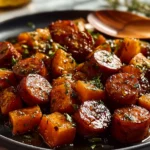Beef and cheese chimichangas are a staple in both Mexican and Tex-Mex cuisines, offering a delicious fusion of flavors wrapped in a crispy tortilla. Originating from the southern regions of North America, these deep-fried delights have captivated food enthusiasts with their rich and savory fillings.
- History and Origin: The chimichanga, often considered a happy accident in the kitchen, is believed to have been invented when a burrito accidentally fell into a deep fryer. This serendipitous event led to the creation of a dish now beloved across many cultures, especially in regions bordering Mexico.
- Popularity: Today, chimichangas have gained immense popularity, not just in their places of origin but globally. They are particularly prized for their versatility and the ease with which they can be customized to suit different palates and preferences.
In preparing a traditional beef and cheese chimichanga, the selection of ingredients plays a pivotal role in defining the flavors and overall experience. Ground beef, chosen for its fat content and flavor, forms the base of the filling, complemented by a rich blend of cheeses that melt beautifully when fried. When combined with the right spices and wrapped in a soft flour tortilla, the result is an irresistible dish that promises a delightful crunch with every bite.
Discover more about the origins and cultural significance of Mexican cuisine, which encompasses a variety of traditional dishes including chimichangas. Additionally, for those interested in the broader context of how dishes like chimichangas fit into the Tex-Mex culinary scene, further reading is available here.
This introduction sets the stage for exploring the essential ingredients and cooking techniques that make beef and cheese chimichangas a favorite for many. By understanding the roots and widespread appeal of this dish, we can better appreciate the nuances that go into preparing it perfectly.
Key Ingredients :
The success of a beef and cheese chimichanga hinges on the quality and blend of its key ingredients. Each component contributes to the overall taste and texture, making the selection process crucial for achieving the desired flavor profile.
- Ground Beef: Typically, a higher fat content in the beef ensures juiciness and flavor. Opt for ground chuck or a custom blend that includes some brisket for an enhanced taste.
- Cheese Varieties: The cheese should be melt-friendly. A blend of cheddar and Monterey Jack provides a nice balance of flavor and gooey texture, crucial for the ultimate chimichanga experience.
- Beans: Refried beans add creaminess and body to the filling, complementing the meat perfectly.
- Spices: A combination of chili powder, cumin, and garlic powder offers the quintessential Mexican flair, pivotal in chimichangas.
- Tortillas: Flour tortillas are traditional for chimichangas due to their ability to crisp up nicely while maintaining structural integrity when fried.
- Additional Ingredients: Onions and green chilis enhance the filling with their sharpness and mild heat, respectively.
For those looking to perfect their chimichanga preparation, understanding the role of each ingredient is essential. Ground beef provides the foundation, offering richness and depth, while the cheese adds a creamy contrast that is simply irresistible. Spices infuse the dish with traditional flavors that are bold and inviting.
Incorporating a variety of cheeses can elevate the dish further, and for this, exploring different types of cheese can be very helpful. Additionally, for an in-depth look at preparing and choosing the best ground beef, refer to the comprehensive guide on beef cooking techniques.
By carefully selecting each ingredient and understanding their interactions within the dish, chefs and home cooks alike can create a beef and cheese chimichanga that is both authentic and personalized to their taste preferences.
Cooking Techniques :
Mastering the cooking techniques for beef and cheese chimichangas ensures that each bite delivers the perfect mix of crunchy exterior and savory, melty interior. Here’s a step-by-step guide to achieving the ideal chimichanga:
- Browning the Beef: Start by cooking the ground beef over medium-high heat until it’s thoroughly browned. This step is crucial for developing a deep, rich flavor.
- Mixing the Filling: To the browned beef, add the refried beans, chopped onions, minced garlic, and your spice mix of chili powder, cumin, and oregano. Cook the mixture for a few more minutes to allow the flavors to meld.
- Preparing Tortillas: Warm the flour tortillas in the microwave or on a skillet to make them pliable. This prevents them from breaking when rolling.
- Assembling: Spoon the filling onto the center of each tortilla, add a generous amount of cheese, and fold the tortilla to enclose the filling securely, using toothpicks if necessary to hold them together.
- Frying: Heat oil in a deep skillet and fry the chimichangas until they are golden and crispy. This usually takes just a few minutes on each side.
Ensuring the oil is hot enough before frying is critical for that perfect crispy texture without absorbing too much oil. For more on frying techniques, a guide on the best oils for frying can provide additional insights.
Moreover, the right kitchen tools can make the preparation process smoother and safer. For those interested in enhancing their kitchen setup, explore various kitchen cooking tips that include choosing the right utensils and maintaining safety in the kitchen.
By carefully following these steps, you can create delicious beef and cheese chimichangas that are perfect for any gathering or family meal. Each element, from the crispy tortilla to the rich, flavorful filling, plays a pivotal role in crafting the ultimate chimichanga experience.
Serving Suggestions :
Once your beef and cheese chimichangas are golden and crispy, it’s time to think about how to serve them. Proper accompaniments not only enhance the dish but also turn it into a well-rounded meal. Here are some suggestions for what to serve with chimichangas:
- Spanish Rice: A side of flavorful Spanish rice complements the textures and flavors of the chimichanga.
- Guacamole: A dollop of fresh, zesty guacamole adds creaminess and a touch of brightness.
- Salsa: Choose from a variety of salsas, such as salsa verde or a chunky tomato salsa, to add a spicy or tangy note.
- Sour Cream: A classic topping that provides a cooling contrast to the spicy elements of the dish.
- Salad: A light, crisp salad with a lime vinaigrette can balance the richness of the fried chimichangas.
For those looking to dive deeper into side dish preparations, particularly Spanish rice, consider exploring recipes and techniques on Pinterest, such as this collection of Mexican side dishes. Additionally, tips on making the perfect guacamole or salsa can significantly enhance your Tex-Mex cooking experience.
Furthermore, the presentation is key to making your meal inviting. Drizzling the chimichangas with a little of the sauce from cooking, sprinkling with extra cheese, and arranging your sides tastefully can make your dish visually appealing. Interested in more food presentation ideas? Check out these creative food presentation tips to elevate your plating skills.
By pairing your beef and cheese chimichangas with these thoughtful sides and presenting them attractively, you can create a dining experience that is both satisfying and visually delightful. Each element of the meal works together to provide a balance of flavors and textures, making your chimichangas the star of the table.
Customization and Variations :
Chimichangas are wonderfully versatile, allowing for numerous customizations and variations that can cater to different dietary preferences and taste buds. Here are some creative ideas to tweak the traditional beef and cheese chimichanga recipe:
- Vegetarian Options: Swap the ground beef for a mixture of mushrooms and black beans for a hearty, vegetarian-friendly alternative.
- Chicken Chimichangas: Use shredded cooked chicken in place of beef for a lighter yet equally tasty filling.
- Spicy Kick: Add extra diced jalapeños or a dash of hot sauce to the filling for those who prefer a spicier dish.
- Low-Carb Version: For a lower-carb option, try using low-carb tortillas or even lettuce wraps instead of traditional flour tortillas.
- Cheese Variations: Experiment with different types of cheese such as pepper jack for more heat or a smoked cheese for added depth.
Incorporating these variations not only keeps your menu exciting but also accommodates the dietary needs and preferences of your guests or family. Additionally, exploring different cheese varieties can enhance the flavors and textures in your chimichangas, making them a new favorite each time.
Moreover, don’t forget that the method of preparation can also vary. While deep-frying is traditional, baking in the oven might be a healthier alternative that still delivers a satisfying crunch. For those curious about alternative cooking methods, further guidance is available through this exploration of Tex-Mex cuisine, where chimichangas hold a notable place.
By embracing these adaptations, you ensure that your beef and cheese chimichangas remain a dynamic and welcoming dish for all occasions, effortlessly adjusting to meet a range of culinary needs and preferences.
FAQs :
When diving into the delicious world of beef and cheese chimichangas, several common questions arise. Here’s a curated FAQ section to help ensure your cooking experience is as smooth and enjoyable as possible:
- How do I store leftover chimichangas?
- Cool to room temperature, wrap tightly in aluminum foil or plastic wrap, and refrigerate for up to 3 days. For longer storage, freeze them for up to 3 months.
- What’s the best way to reheat chimichangas?
- For best results, reheat in an oven at 350 degrees Fahrenheit for about 10-15 minutes if refrigerated, or about 20 minutes if frozen. This method helps maintain the crispy texture. Alternatively, for a quick reheat, use the microwave, but be aware this may soften the crust.
- Can I make chimichangas in an air fryer?
- Yes, air frying is a great alternative to traditional frying. Preheat your air fryer to 400 degrees Fahrenheit and cook the chimichangas for about 8 minutes, or until crispy and heated through.
- Are there any tips for ensuring my chimichangas don’t fall apart while frying?
- Make sure to tuck the ends of the tortillas securely and use toothpicks to hold them together during frying. Also, do not overcrowd the frying pan, as this can lower the oil temperature and cause the chimichangas to soak up oil and potentially unravel.
- How can I make my chimichangas healthier?
- Consider baking or air frying instead of deep frying to reduce oil intake. You can also use leaner meats such as ground turkey or chicken and incorporate more vegetables into the filling.

lemon garlic chicken bites
- Author: Easy Recipes
Ingredients
1 pound boneless, skinless chicken breasts, pat dry with paper towel, cut into 1-inch pieces
½ teaspoon dried oregano
½ teaspoon dried basil
2 tablespoons finely chopped fresh parsley
½ teaspoon kosher salt
¼ teaspoon black pepper
4 tablespoons unsalted butter, divided
2 tablespoons minced garlic
½ medium lemon, juiced (about 2 tablespoons)
Instructions
In a small bowl, combine oregano, basil, parsley, salt, and pepper. Sprinkle evenly over all sides of the chicken pieces. Toss to evenly coat.
In a 12-inch skillet over medium heat, melt 2 tablespoons of the butter. Tilt the pan slightly to coat the base of the pan.
Once melted, add chicken to the pan in an even layer to ensure even cooking. (Do not overcrowd the pan.) Cook 8-10 minutes, flipping halfway through, or until all sides are golden brown and the chicken is mostly cooked through.
Add the remaining butter. Once melted, add garlic and cook one more minute, or until fragrant, and the chicken is cooked through to an internal temperature of 165°F.
Drizzle lemon juice over chicken and stir to combine. Serve immediately.




